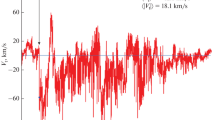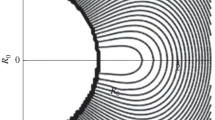Abstract
The hydrodynamic properties of a steadily expanding corona are explored for situations in which departures from spherically symmetric outflow are large, in the sense that the geometrical cross section of a given flow tube increases outward from the Sun faster than r 2 in some regions. Assuming polytropic flow, it is shown that in certain cases the flow may contain more than one critical point. We derive the criterion for determining which of these critical points is actually crossed by the transonic solution which begins at the Sun and extends continuously outward. Next, we apply the theory to geometries which exhibit rapid spreading of the flow tubes in the inner corona, followed by more-or-less radial divergence at large distances. This is believed to be the type of geometry found in coronal hole regions. The results show that, if this initial divergence is sufficiently large, the outflow becomes supersonic at a critical point encountered low in the corona in the region of high divergence, and it remains supersonic at all greater heights in the corona. This feature strongly suggests that coronal hole regions differ from other open-field regions of the corona in that they are in a ‘fast’, low density expansion state over much of their extent. Such a dynamical configuration makes it possible to reconcile the low values of electron density observed in coronal holes with the large particle fluxes in the associated high speed streams seen in the solar wind.
Similar content being viewed by others
References
Allen, C. W.: 1973, Astrophysical Quantities, Athlone Press, London, 176.
Altschuler, M. D., Trotter, D. E., and Orrall, F. Q.: 1972, Solar Phys. 26, 354.
Cushman, G. W. and Rense, W. A.: 1976, Astrophys. J. Letters, in press.
Durney, B. R. and Pneuman, G. W.: 1975, Solar Phys. 40, 461.
Gabriel, A. H.: 1971, Solar Phys. 21, 392.
Holzer, T. E.: 1976, J. Geophys. Res., in press.
Hundhausen, A. J.: 1972, Coronal Expansion and Solar Wind, Springer-Verlag, New York.
Krieger, A. S., Timothy, A. F., and Roelof, E. C.: 1973, Solar Phys. 29, 505.
Nolte, J. T. and Roelof, E. C.: 1973, Solar Phys. 33, 241.
Nolte, J. T., Krieger, A. S., Timothy, A. F., Gold, R. E., Roelof, E. C., Vaiana, G., Lazarus, A. J., Sullivan, J. D., and McIntosh, P. S.: 1976, Solar Phys., 46, 303.
Munro, R. H. and Withbroe, G. L.: 1972, Astrophys. J. 176, 511.
Munro, R. H. and Jackson, B.: 1976, Solar Phys., in preparation.
Parker, E. N.: 1958, Astrophys. J. 128, 664.
Parker, E. N.: 1960, Astrophys. J. 132, 821.
Parker, E. N.: 1963, Interplanetary Dynamical Processes, Interscience, New York-London.
Parker, E. N.: 1965, Space Sci. Rev. 4, 666.
Author information
Authors and Affiliations
Additional information
The National Center for Atmospheric Research is sponsored by the National Science Foundation.
Rights and permissions
About this article
Cite this article
Kopp, R.A., Holzer, T.E. Dynamics of coronal hole regions. Sol Phys 49, 43–56 (1976). https://doi.org/10.1007/BF00221484
Received:
Revised:
Issue Date:
DOI: https://doi.org/10.1007/BF00221484




